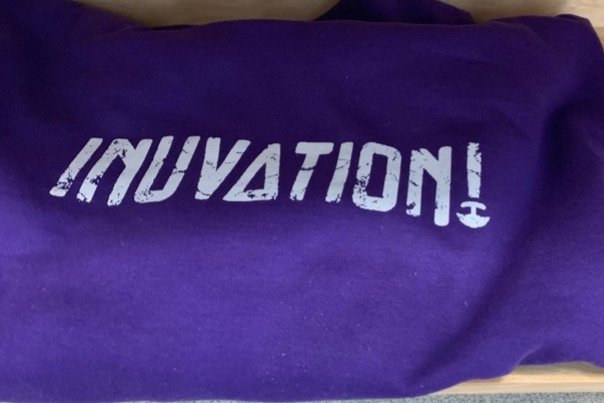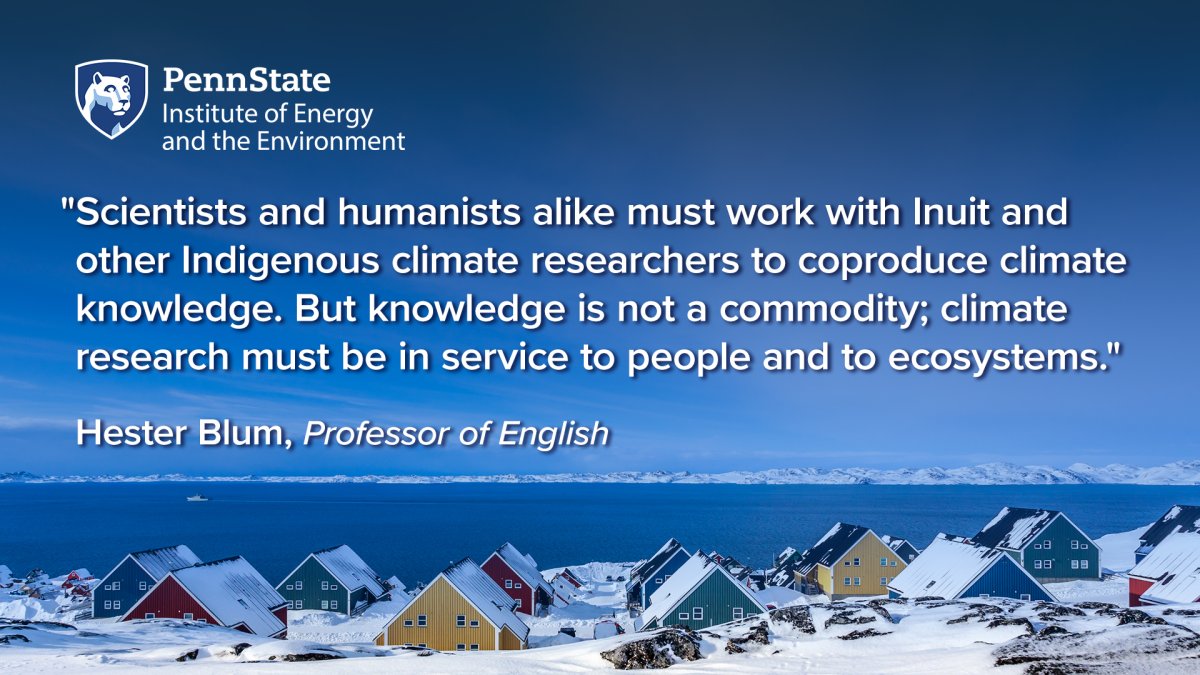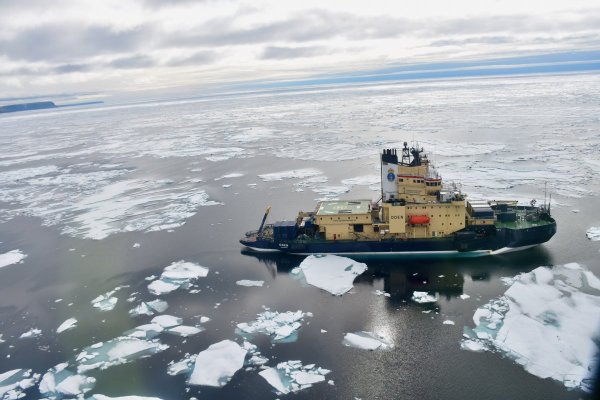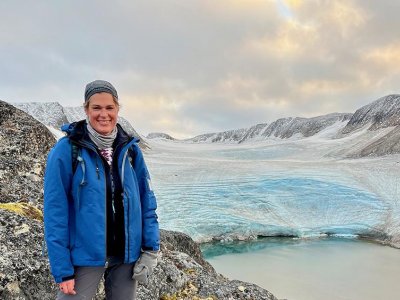Inuit are the first Arctic researchers. Mia Otokiak spoke this truth to an audience of climate scientists on an icebreaker at 74˚ N in the Arctic Ocean. We were members of the NSF-sponsored Northwest Passage Project (2019), which consisted of Arctic researchers as well as a documentary film crew. (I am a Penn State English professor and polar humanities scholar, and I served as Arctic historian on the voyage.) Mia taught us about Inuit Knowledge or Inuit Qaujimajatuqangit, which means “that which Inuit have long known to be true.” Inuit are the first to survive in the Arctic and the first to learn about the region, Mia reminded us, and her words had an electric effect on the assembled expedition members, most of whom were American academic researchers. Mia is a young Inuk woman from Cambridge Bay in Nunavut; along with Gibson Kelly Porter of Gjoa Haven in Nunavut, she had joined the Arctic climate science expedition in part as representatives of Ikaarvik, an organization founded to involve Inuit youth in Arctic science in meaningful ways.

Ikaarvik is working to address two cultural and professional imperatives. For one, the program empowers Inuit youth to recognize and make use of their own skills and experience in the North. For two, Ikaarvik aims to recalibrate the relationship that visiting researchers to the Arctic have to local Indigenous populations, which often consists only of hiring Inuit guides or buying supplies, rather than recognizing the deep climate knowledge held by Inuit community members. During the Northwest Passage Project, Mia and Gibson laid out for us the recommendations that Ikaarvik makes to scientists traveling to Nunavut: get to know the community, ideally through face-to-face meetings. Talk with community members. Be a person before being a scientist. Have your Inuk guide involved in every step of your research. Set up a table in the local community's Co-Op or Northern Store for a few hours, with handouts explaining what you are researching, so that you can introduce yourself to the community.
Community is central to Inuit Arctic research. The principles of Inuit Qaujimajatuqangit emerge from communal knowledge developed over time, which Inuit Societal Values defines as “a body of accumulated knowledge of the environment and the Inuit interrelationship with the elements, animals, people and family.” This is knowledge that stresses mutuality and collectivity. We spoke with other members of Ikaarvik when the Northwest Passage Project expedition members spent a day in Pond Inlet or Mittimatalik, which with a population of 1900 people is one of the larger Nunavut towns. Alexandra Anaviapik, a graphic designer, artist, and cultural guide on Arctic cruises, reminded us that “research must be holistic, across levels. We are part of the environment. If geology is just geology, then there is no connectedness.” In this spirit of Inuit innovation and interconnectedness, Alex had designed a witty sweatshirt for sale in Pond Inlet's Nattinnak Visitor Centre shop, which reads "Inuvation!" The base of the exclamation point in her design is not a period but instead an image of an ulu, the all-purpose knife used by Inuit women for thousands of years. Alex’s insights reminded me of an observation on the benefits of holistic knowledge made by the first mate of our Northwest Passage ship: “I see scientists from a sailor's perspective—their knowledge is like an icicle, it gets very very narrow at the tip.” Mia and Gibson helped us to broaden our understanding of what knowledge is.

I had joined the expedition at the invitation of the filmmaker who conceived of a film on the history of the Northwest Passage and contemporary climate change (the resulting documentary, Frozen Obsession, is available via PBS; Penn State’s former Polar Center contributed $3,000 toward my participation). Like all polar travel, the Northwest Passage Project encountered many logistical challenges. The expedition went through five ships in five years of planning: the first four of those ships had either canceled, or ended up in emergency dry dock, or ran aground in uncharted Arctic waters, or was recalled by Russia. Polar exploration is never easy; even in the twenty-first century, polar expeditions remain dangerous and very difficult to pull off. For all the supposed commercial promise of an ice-free Northwest Passage or Northern Sea Route, these remain hazardous waters, with rescue sometimes impossibly distant.
I was the lone polar humanist among Arctic scientists, and in the five years of preparation for the Northwest Passage Project I had petitioned to contribute more to the project's mission, beyond the lectures on Arctic history and literature that I was expected to provide. It wasn’t until a few days into the voyage that I realized that no one on the scientific team thought of me as part of their project at all. To them, I was classified as a guest of the documentary team—a talking head for the film, a scholar of background historical information, unrelated to the science mission. It was certainly true that my participation was solicited by the documentary team, who liked the idea of having a literary historical scholar (and a woman) on camera talking about climate change. What institutional structures, or what elasticity of vision, would have permitted the full Northwest Passage Project participation of a humanist? It's possible that the multi-year logistical challenges in launching the expedition—its fits, starts, and jettisoned ships—led to a tightening of control over the parameters of the expedition, a caution that led to constricted objectives rather than expansive possibility.

Even more startling, I realized only after the expedition that Mia and Gibson, the Inuit scientists, were also excluded from the initial science plans, too, although they both participated fully in the scientific experiments. They, too, were guests of the film crew, part of the vision of the documentary director—not the PIs of the NSF grant. To repeat with a difference the question I pose above: what institutional structures, or what elasticity of vision, would have permitted the full Northwest Passage Project participation of Inuit scientists from the start?
What I learned from Mia and Gibson during the Northwest Passage Project was not only how to practice more ethical research as non-Inuit visitors to the North. Far more significantly, our Inuit shipmates taught us the necessity of the coproduction of climate knowledge by Indigenous populations and visiting researchers in the North. One of the themes of the Penn State Climate Consortium, “Indigenous and Local Knowledge Systems,” is defined as knowledge that can “complement and enhance scientific approaches to mitigating climate change and building resilient communities.” As Mia and Gibson underscored for us, Indigenous Knowledge is not a complement to science—it is science.

Conversations I have had with Mia and Gibson and with other Inuit have reshaped my understanding of polar research methodologies. The scientists on our Northwest Passage Project expedition were primarily collecting water samples; as a polar humanist, as one of the scientists framed it, I was "collecting stories." But as Gibson and Mia have come to make me realize, both collecting scientific data and collecting stories can be forms of resource extraction: not fossil fuel extraction, but intellectual resource extraction. Systems of knowledge, Indigenous and non-Indigenous alike, are conditioned by climate; what the industrialized Western world experiences as present climate emergency is, for Indigenous peoples, only the most present iteration on a millennium-long continuum of extractive destruction. Scientists and humanists alike must work with Inuit and other Indigenous climate researchers to coproduce climate knowledge. But knowledge is not a commodity; climate research must be in service to people and to ecosystems.
Hester Blum is a professor of English who teaches courses in nineteenth-century US literature and culture, oceanic and polar studies, material text studies and the history of the book, popular fiction, Herman Melville, and the environmental humanities. She participated in an Arctic climate change expedition in 2019; a documentary made of our Northwest Passage Project is streaming. She also joined the 38th Voyage of the Charles W. Morgan, the world's last surviving nineteenth-century wooden whaleship; traveled to Antarctica in 2022 with the Penn State Alumni Association; and returned to the Arctic in an expedition to Svalbard with The Arctic Circle in 2022.
Penn State is honored to be hosting Mia Otokiak Beattie and Gibson Porter at the 2024 Climate Solutions Symposium as the featured speakers on the panel “The Original Arctic Climate Scientists: Inuit Knowledge.”





